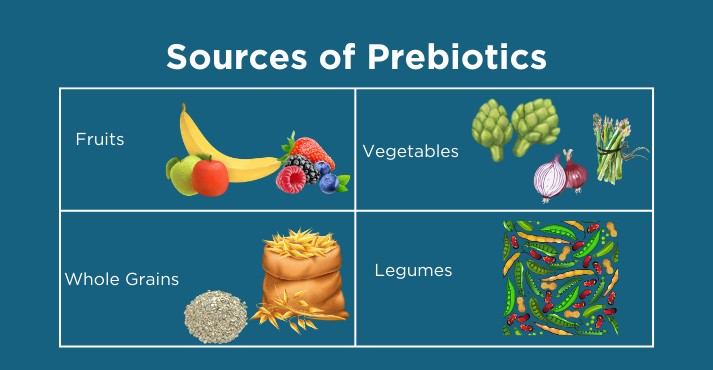In recent years, gut health has become a hot topic in the health and wellness industry, with growing recognition of its crucial role in overall well-being.
Studies show that about 70% of the immune system is housed in the gut, highlighting the importance of maintaining a healthy gut flora.
This is where prebiotics and probiotics come into play, offering significant benefits for digestive health.
Prebiotics are non-digestible fibers that feed the beneficial bacteria in our gut, helping them thrive and maintain a balanced environment.
Probiotics are live bacteria and yeasts that are good for our digestive system, found in fermented foods such as yogurt, kefir, and sauerkraut.

Probiotics: The Friendly Gut Residents
Probiotics are live microorganisms that offer various health benefits when consumed adequately.
These beneficial bacteria, often called “friendly” or “good” bacteria, play a vital role in maintaining a healthy gut microbiome, which is essential for overall health.
Common probiotic strains include Lactobacillus and Bifidobacterium, which are extensively studied for their positive effects on health.
Probiotic Benefits
Probiotics support digestion by helping to break down food, absorb nutrients, and maintain a balanced gut flora.
They are known to boost the immune system by enhancing the production of antibodies and promoting the activity of white blood cells.
Additionally, probiotic drinks can aid in specific health conditions such as irritable bowel syndrome (IBS), diarrhea, and even allergies.
Emerging research also suggests that probiotics may affect mental health by influencing the gut-brain axis. However, more studies are needed to understand this connection entirely.
Sources of Probiotics

Probiotics can be found in various functional food sources and supplements, making them accessible for daily consumption. Some of the most common sources include:
- Yogurt with Live and Active Cultures: Yogurt is among the most popular probiotic-rich foods. It contains live and active cultures of beneficial bacteria, such as Lactobacillus and Bifidobacterium, which can help improve gut health. When choosing yogurt, look for labels that specify “live and active cultures” to ensure you are getting the probiotic benefits.
Considering the modern development in food science, plant-based dairy alternatives such as yogurt include live, active cultures, which are probiotics.
- Kefir: Kefir is a fermented milk drink that contains a wide variety of probiotic strains. It is similar to yogurt but has a thinner consistency and often contains more probiotics due to its fermentation process. Kefir can be a great addition to smoothies and cereals and can be consumed independently.
- Kombucha: Kombucha is a fermented tea that, depending on the fermentation process, contains probiotics. It’s made by fermenting sweet tea with a mixture of bacteria and yeast called a SCOBY. Kombucha’s probiotic content can vary, so choosing products from reputable brands that indicate the presence of live cultures is essential.
- Probiotic Supplements: Supplements are convenient for those who may not get enough probiotics from food. Probiotic supplements, including capsules, tablets, and powders, come in various forms and contain concentrated doses of beneficial bacteria. When selecting a supplement, it is crucial to choose one with a high count of live bacteria and strains that are well-researched for their health benefits.
Incorporating probiotics into your daily routine can significantly impact gut health and overall well-being.
For businesses in the health and wellness industry, offering probiotic-rich products or supplements can meet the growing consumer demand for gut health solutions and provide a competitive edge.
Understanding the benefits and sources of probiotics is essential for promoting their use and ensuring that customers receive the full range of health benefits these friendly gut residents offer.
Prebiotics: Food for the Gut Bugs
Prebiotics are non-digestible fibers that feed the beneficial bacteria in our gut. Unlike probiotics, which are live microorganisms, prebiotics are indigestible by the human body but are crucial for promoting the growth and activity of good bacteria in the gut microbiome.
Prebiotics help maintain a balanced and healthy gut flora by providing a nourishing environment for these bacteria.
How Prebiotics Work
Prebiotics pass through the upper part of the gastrointestinal tract undigested and reach the colon, where the gut bacteria ferment them. This fermentation process produces short-chain fatty acids (SCFAs), which are beneficial for gut health.
The presence of prebiotics in the diet stimulates the growth and activity of probiotics, enhancing their ability to maintain a healthy gut microbiome.
A well-nourished microbiome can improve digestion, boost the immune system, and improve overall health.
Common Prebiotic Sources

The following are the familiar and readily available sources of probiotics:
- Fruits: Apples, bananas, and berries are rich in prebiotic fibers. These fruits contain compounds such as pectin and inulin, which serve as food for beneficial gut bacteria.
- Vegetables: Artichokes, asparagus, and onions are excellent sources of prebiotics. These vegetables are high in inulin and other non-digestible fibers that support the growth of probiotics in the gut.
- Whole Grains: Oats and barley are whole grains that contain significant amounts of beta-glucan and other prebiotic fibers. Including these grains in your diet can help maintain a healthy gut microbiome.
- Legumes: Beans and lentils are legumes rich in prebiotic fibers. They also provide a substantial amount of resistant starch, which feeds the beneficial bacteria in the gut.
The Power Duo: Prebiotics and Probiotics
Prebiotics and probiotics work together to support gut health. Prebiotics feed the probiotics, helping them grow and create a healthy gut environment.
Synergistic Relationship
Probiotics, the live beneficial bacteria, need a consistent source of nutrition to survive and multiply in the gut. Prebiotics serve as this source of nutrition, offering the fibers and compounds that probiotics feed on.
When prebiotics and probiotics are consumed together, prebiotics enhance the effectiveness of probiotics by creating an optimal environment for their growth and activity.
This close partnership helps create a healthier and more balanced gut essential for overall well-being.
Potential Benefits of Combining Prebiotics and Probiotics

Here are the main benefits of combining probiotics and prebiotics.
- Improved Digestion and Nutrient Absorption: A well-balanced gut microbiome, supported by prebiotics and probiotics, can improve digestion and nutrient absorption efficiency. This can lead to better overall health and increased energy levels.
- Stronger Immune System: The gut is home to many of the body’s immune cells. A healthy gut microbiome, bolstered by the combined effects of prebiotics and probiotics, can enhance the body’s immune response, helping to fend off infections and illnesses.
- Reduced Risk of Certain Gut-Related Conditions: A thriving gut microbiome can help prevent and manage gastrointestinal issues such as irritable bowel syndrome (IBS), inflammatory bowel disease (IBD), and diarrhea. Combining prebiotics and probiotics can reduce inflammation, improve gut barrier function, and promote regular bowel movements.
Frequently Asked Questions (FAQs)
Which is better, probiotic or prebiotic?
Probiotics and prebiotics work best together, supporting each other in promoting gut health. Probiotics are good bacteria, and prebiotics are fibers that feed these bacteria, working together to support optimal digestive health.
How do you know if you need prebiotics?
Prebiotics might benefit you if you experience digestive issues like bloating, constipation, or irregular bowel movements. They help nourish beneficial gut bacteria, improving digestion and overall gut health.
Conclusion
Prebiotics and probiotics serve different roles but are crucial in maintaining a healthy gut.
Probiotics are live beneficial bacteria that help balance the gut microbiome, aid digestion, and support overall health.
Prebiotics, however, are non-digestible fibers that feed these good bacteria, allowing them to flourish and perform their functions effectively.
Incorporating both into your diet can enhance the gut environment, improve nutrient absorption, and support the immune system.
A balanced intake of prebiotics and probiotics, whether through food sources like yogurt and fermented vegetables or supplements, can contribute to long-term well-being.
By nurturing this partnership, you can maintain a healthier digestive system and, by extension, a healthier body.





























